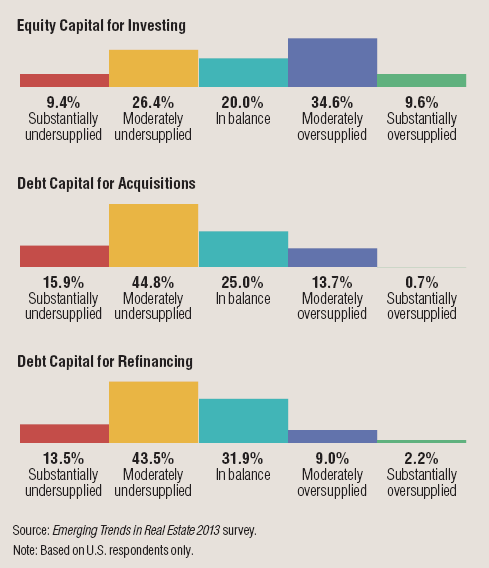
Once considered a last-resort financing option, asset-based lending (ABL) has become a popular choice since the 2008 economic downturn for companies lacking access to more traditional capital sources. Although the capital markets froze in 2008, lending for commercial real estate (CRE) has begun to return, but, thus far debt providers have focused on core cities and select asset types during the recovery phase.
In 2013, property values in many secondary markets will gradually rise, creating more equity value; however, in many cases, term debt will not be readily available to leverage that new equity. Therefore, there may be an opportunity for ABLs to capture more business by including real estate in their collateral pools, which commonly have included such non-real estate assets as inventory, accounts receivable, machinery and other more liquid assets.
Historically, ABL tends to work best in industries with higher levels of accounts receivable and inventory. These include durable goods manufacturers, wholesalers, consumer product companies, rental companies/equipment leasing, energy companies and retailers. While many large companies use asset based loans as part of their capital structure, our focus is on small to midsized companies in the preferential ABL industries.
These types of companies tend to use commercial properties in the industrial, retail and smaller office asset classes. Because small to midsized businesses, in general, rely on commercial banks for their lending needs (commercial banks comprise nearly 50% of the commercial real estate lending in the U.S.), our discussion of CRE debt providers will focus on commercial banks rather than other debt options, such as commercial mortgage backed securities, insurance companies or other sources.
Small and midsized companies use a combination of loan options to finance their businesses. Asset based lending is one capital market product that is integrated with other financing instruments to fill out a company’s debt structure. If one type of financing option is impaired or enhanced, it will force businesses to adjust their levels of other sources of capital.
Over the past three years, commercial real estate lending has been significantly constrained. For small and midsized businesses, the lack of access to commercial real estate financing has increased the size and utilization rates of their asset based loans. If the economy gradually improves in 2013, businesses may require more immediate capital for project financing needs (such as inventory purchases, mergers, acquisitions and debt purchasing). Why is commercial real estate financing so limited, what is the outlook for next year and where are the opportunities for asset based lenders?
Decline of Commercial Real Estate Values
The Great Recession of the late 2000s had numerous contributing factors, but the most direct cause was bad lending to households and businesses. It is widely believed that the single largest trigger was the collapse in value of the mortgage backed security. This was directly related to the sharp decline in residential home values, and many market observers felt that commercial mortgage backed securities and commercial property values would follow the same pattern, causing a second wave of the financial crisis.
While there certainly were many losses and write downs in the commercial real estate markets, dramatic large-scale fire sales of commercial properties never materialized, even though billions of dollars had been directed into commercial real estate-related investment funds waiting to purchase these deeply discounted opportunities.
The late 1980s and early 1990s witnessed a similar, although much smaller, collapse in commercial real estate value. The Resolution Trust Corporation (RTC), a temporary federal agency that was created to manage the disposal of nearly $400 billion of assets from failed savings and loan (S&L) institutions, was used to help liquidate real estate and financial assets inherited from insolvent thrift institutions. In late 2008 and 2009, there were rumors that the government was going to provide an “RTC2” type solution to clearing the bad debts.
In anticipation of this development, investors set up funds to purchase these RTC2 type discounted properties, but, for a number of reasons (largely due to the massive size of the real estate problem and increased complexity of securities), this government imposed liquidation approach was not employed. By late 2009, there was a huge amount of capital allocated to finding and buying distressed commercial real estate projects.
Even though the RTC2 method was not employed, many market participants recognized the fact that commercial real estate values had declined and that many commercial banks were in need of capital. Therefore, it was expected that banks would respond to the real estate crash either by foreclosing and selling commercial properties or by taking aggressive positions against borrowers, forcing them to resize their loans with new equity investments. Instead, most banks took a more measured and patient course (whether by choice or the fact they had limited options), granting many borrowers loan extensions or modifications. This method has been coined ‘extend and pretend,’ which has delayed dealing with many problem loans in secondary and tertiary markets and hindered the reset of prices to lower levels.
The financial meltdown of the late 2000s, combined with persistent global economic uncertainty and volatility has pushed global investors to make a “flight to quality” by purchasing U.S. Treasuries. A similar trend was recognized in commercial real estate as investors have concentrated investments in the safer “core markets” of New York, Boston, Washington, D.C., the Bay Area, Southern California, and Seattle. These six markets, which led the CRE industry out of recession, are also called the “gateway cities” or the “sexy six.”
Building values in these cities have recouped 42% of their decline since bottoming in January 2010, according to the Moody’s/RCA Commercial Property Price index. Investor interest in those core markets has been intense since mid-2009, leading to bidding wars and higher price tags. Capitalization rate compression and increased valuation happened much faster than anticipated in the core markets, which caused a growing list of investors to begin to search for opportunities in secondary markets.
Just as fixed income investors have moved further out on the risk curve and allocated more capital into riskier high yield corporate bonds, real estate investors slowly have begun to invest in secondary markets in search of yield. This investment activity gradually has been increasing property valuations in those secondary markets. Another positive contributing factor is the lack of new supply. The severe recession delayed or destroyed plans for any new construction. With constrained supply and improving economic fundamentals in some markets, ongoing slow improvement in both vacancies and rents are expected to continue in 2013.
Due to the ultralow interest rate environment, European government deficits and the economic slowdown in Asia, select U.S. commercial real estate assets should be a favorable investment class in 2013, because they will outperform fixed-income investments and offer more stability than equities.
Regional and Community Commercial Banks
Many small and midsized businesses rely on smaller regional and community banks to finance their real estate and their businesses. Although equity investors are migrating into secondary markets and fundamentals are improving, the real estate debt providers, specifically commercial banks, are moving at a more measured pace.
Not only are there significant macroeconomic headwinds causing hesitation, banks also face internal strife, including dealing with a host of factors limiting origination of new loans. Legacy issues of non-performing CRE loans are still a focus and consume a lot of attention. Housing-related loans continue to drain capital and resources as foreclosures and lawsuits carry on. In 2013, tens of billions of dollars of CRE loans will be maturing, and resources need to be allocated to handle the resolution of those loans.
After the recent downturn, there are simply fewer healthy regional and community banks left standing. Those smaller lenders that survived typically had an over allocation of commercial real estate and now are making efforts to diversify and limit new CRE loans. Smaller banks are concerned about the changing regulatory environment and are evaluating options to find economies of scale needed to comply with new banking regulations. All of these factors are constraining available capital and distracting bankers from their core business of making new loans.
According to the Emerging Trends in Real Estate 2013 report released by the Urban Land Institute, nearly 60 percent of the respondents polled believe there is moderate or substantial undersupply of debt capital for acquisition and refinancing.

Property Types and Locations
The U. S. economy still faces significant headwinds in its journey to recovery. Such hurdles include the European debt crisis, the slowdown in Asia and international political turmoil. However, the uptick in U.S. household net worth, modest increase in consumer spending and the decline of household debt service payments does indicates some moderate U.S. economic expansion in 2013. Industrial demand and increasing retail spending will result in higher occupancy and rental rates for industrial and retail properties. However, sluggish employment is slowing demand for office space, and caution should be used when evaluating any opportunities in suburban office space.
The first signs of increased residential construction are emerging, which will lead to more light industrial use, such as building supply warehouse and distribution facilities, construction rental equipment, and retail locations for construction equipment and supplies. These are all industries that consume more physical space and have traditionally relied heavily on asset based loans in their capital structure.
Rising port activity and robust energy related activity also are driving demand for industrial space. In preparation for the expansion of the Panama Canal and the resulting changes in trade lanes, values have increased for industrial properties in select markets. These markets include Houston, New Orleans, Mobile, Miami, Jacksonville, Savannah, Charleston, Norfolk, Baltimore, and the New York–New Jersey region.
According to the National Association of Realtors, “industrial vacancy rates are forecast to decline from 10.7% in the third quarter of this year to 10.5% in the third quarter of 2013. Annual industrial rent is likely to rise 1.7% in 2012 and 2.4% next year. Net absorption of industrial space nationally is seen at 59.8 million square feet this year and 67.2 million in 2013. Retail vacancy rates are projected to decline from 10.9 percent in the third quarter to 10.7% in the third quarter of 2013. Average retail rent is forecast to rise 0.8% this year and 1.3% in 2013. Net absorption of retail space should be 10.3 million square feet this year and 20.1 million in 2013.”
Summary
The Commercial Finance Association collected responses from 22 of its largest members engaged in asset based lending and 55% reported an increase in total credit lines; 59% reported an increase in new commitments in the second quarter in 2012. The report also highlighted that the utilization of lenders’ credit lines increased to 41.7% in the second quarter of 2012. This compares to 40.8% in the previous quarter and 40.9% in the same quarter of 2011. Asset-based lending is edging upward, but more opportunities should exist in 2013.
There are select industries in many secondary markets that are outpacing the overall economy. The property values for those assets in those markets are rising, thereby creating equity value that will need to be leveraged if businesses plan to expand. While there are some commercial banks that are servicing these clients with term debt for their commercial real estate, many small and mid-sized businesses will not have access to enough debt providers. These conditions will potentially allow for more asset based loans to originate new commitments if there is an appetite for capturing this increasing commercial real estate equity component.
Carl Marks nor any of its employees, agents, or other representatives makes any representations or warranties, expressed or implied, as to the accuracy or completeness of this article. The opinions expressed in this article are general in nature and are not intended to provide specific advice or recommendations for any individual or association. Contact your banker, attorney, accountant, or tax advisor with regard to your individual situation.